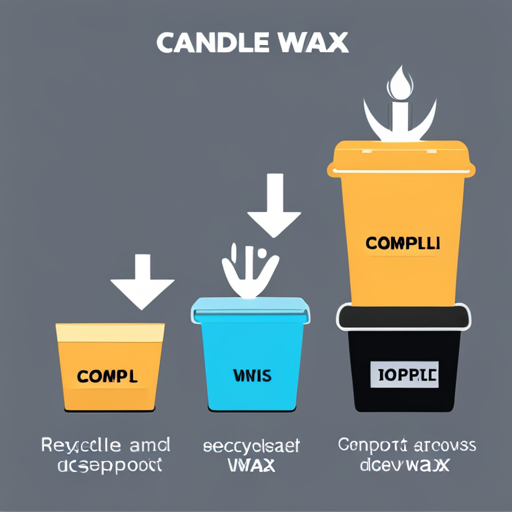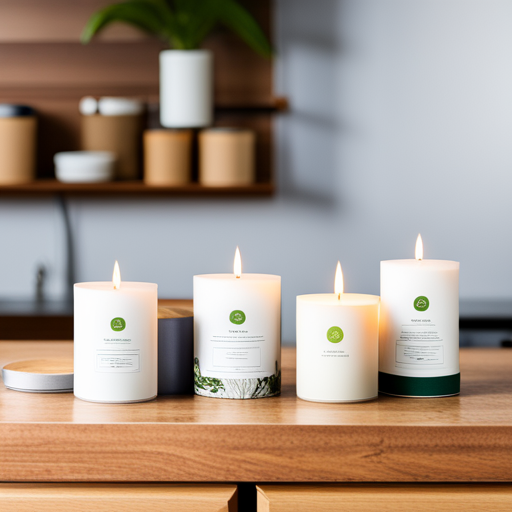In contrast, paraffin wax, derived from petroleum, is non-biodegradable and contains harmful chemicals, taking around 100 years to decompose.
The environmental impact of candle wax, including greenhouse gas emissions and contribution to climate change, should be considered when choosing a candle.
Key Takeaways
– Different types of candle wax have varying decomposition rates, with paraffin wax taking around 100 years to decompose, while soy and coconut wax decompose in 6 weeks and beeswax decomposes in about a month.
– Plant-based waxes like soy, coconut, and beeswax are biodegradable and organic, making them more environmentally friendly options compared to paraffin wax, which is derived from petroleum and contains harmful chemicals.
– It is possible to dispose of candle wax in eco-friendly ways, such as reusing the wax, discarding it in landfills (preferably natural waxes only), or composting it in anti-microbial compost.
– When buying eco-friendly candles, it is important to consider factors beyond just the wax and wicks, such as packaging, perfume ingredients, and overall sustainability.
Types of Candle Wax and Their Decomposition Rates

https://www.youtube.com/watch?v=IfmNKEZH17Y
Plant-based waxes, such as coconut or soy, are biodegradable and organic. Paraffin wax derived from petroleum takes around 100 years to decompose due to its chemical makeup.
These plant-based waxes are a more eco-friendly option for candle production. Coconut and soy wax decompose in about 6 weeks, making them a faster and more sustainable choice.
On the other hand, paraffin wax is non-biodegradable and contains harmful chemicals that can be released into the air when burned. This not only affects indoor air quality but also contributes to greenhouse gas emissions.
Choosing candles made from plant-based waxes is not only better for the environment but also for our health. Making the switch to these natural alternatives can have a positive impact on both the planet and our well-being.
Disposal Methods for Candle Wax

When disposing of candle wax, individuals can choose to either re-use the wax or discard it in a landfill, preferably using natural waxes only.
Here are four methods for disposing of candle wax:
1. Re-use the wax: Melt it down and make wax melts, spare candles, air fresheners, and more.
2. Discard the wax: Put it in a landfill, but remember to melt or freeze it first. This method is best for natural waxes only.
3. Compost the wax: If you have an anti-microbial compost, it can break down soy, beeswax, and coconut wax.
4. Recycle the wax: Look for recycling programs in your area that accept candle wax.
Eco-Friendly Candle Wicks

Most candle wicks, such as wooden, cotton, and hemp wicks, are environmentally friendly and biodegradable if they do not contain lead or metal. These wicks are popular choices for eco-conscious consumers due to their sustainable nature.
Wooden wicks, in particular, have gained popularity for their unique crackling sound and longer burn time. Cotton wicks are another common option as they are natural, renewable, and easily biodegradable. Hemp wicks, made from the fibers of the hemp plant, are also considered eco-friendly. These wicks provide a clean and even burn, without emitting harmful toxins into the air.
When purchasing candles, it is important to check for wicks that are free of lead or metal to ensure a more environmentally friendly experience.
Considerations When Buying Eco-Friendly Candles

When purchasing eco-friendly candles, consumers should consider the overall sustainability of the product. This includes factors such as packaging, perfume, and the type of wax and wicks used. Here are four key considerations to keep in mind:
1. Packaging: Opt for candles that come in reusable glass containers and are packaged in paper or cardboard. This reduces waste and promotes recycling.
2. Perfume: Avoid candles that contain phthalates, as these are harmful to both human health and the environment. Instead, choose candles with essential oil fragrances, which are natural and non-toxic.
3. Wax: Look for candles made from plant-based waxes like soy or coconut, as they are biodegradable and organic. Avoid candles made from paraffin wax, which is derived from petroleum and contains harmful chemicals.
4. Wicks: Opt for candles with environmentally friendly wicks that are made from wood, cotton, or hemp. These wicks are biodegradable and do not contain lead or metal.
Factors Affecting Candle Wax Decomposition and Environmental Impact

Factors such as the type of wax, size and shape of the candle, and environmental conditions can all affect the decomposition and environmental impact of candle wax. The type of wax plays a significant role in decomposition rates. Paraffin wax, for example, takes around 100 years to decompose due to its chemical makeup. In contrast, plant-based waxes like soy and coconut decompose in just six weeks, while beeswax decomposes in about a month.
The size and shape of the candle can also influence decomposition. Larger candles may take longer to break down compared to smaller ones.
Environmental factors such as temperature and humidity can affect the decomposition process as well. Higher temperatures and humidity levels can speed up decomposition, while lower temperatures and drier conditions can slow it down.
The presence of other substances, such as fragrances or dyes, can also impact decomposition rates and environmental impact. Some additives may hinder or delay decomposition, adding to the overall environmental burden.
Decomposition Products of Candle Wax

The decomposition of candle wax produces various byproducts when burned. These include carbon dioxide, water vapor, carbon monoxide, soot, and scent molecules.
When the wax is burned, these byproducts are released into the air. The combustion process produces carbon dioxide and water vapor. On the other hand, carbon monoxide is a result of incomplete combustion.
Soot is formed when the wax does not burn completely, and solid particles are released into the air. This can contribute to indoor air pollution.
The pleasant smell of candles comes from the release of scent molecules. These molecules are released as the wax melts and evaporates.
It is important to manage these decomposition products properly to maintain indoor air quality and minimize their impact on climate change.
Decomposition Rates of Different Types of Candle Wax

Beeswax decomposes in about a month, making it a relatively quick decomposition rate compared to other types of candle wax. This natural alternative is biodegradable and doesn’t contain harsh chemicals. However, it is more expensive than other options. To understand the decomposition rates of different candle waxes, let’s take a look at the table below:
| Type of Wax | Decomposition Rate |
|---|---|
| Paraffin wax | 100 years |
| Soy & coconut wax | 6 weeks |
| Beeswax | about a month |
| Rapeseed wax | varies |
As we can see, paraffin wax has the longest decomposition rate due to its chemical makeup, taking around 100 years to break down. On the other hand, soy and coconut wax decompose in just 6 weeks, making them a more environmentally friendly choice. Beeswax falls in between, decomposing in about a month. It is important to consider these decomposition rates when choosing your candle wax, as it can have an impact on the environment.
Environmental Impact of Candle Wax and Sustainable Options

Choosing sustainable candle options can significantly reduce the environmental impact of candle wax. Here are four reasons why:
1. Use of plant-based waxes: Coconut or soy waxes are biodegradable and organic, making them a more sustainable choice compared to petroleum-derived paraffin wax.
2. Biodegradable and non-toxic: Sustainable waxes like soy, coconut, and beeswax decompose in a matter of weeks or months, releasing fewer harmful chemicals into the environment.
3. Eco-friendly wicks: Opting for wooden, cotton, or hemp wicks ensures that the entire candle is biodegradable and does not contribute to landfill waste.
4. Consideration of packaging and fragrance: Choosing candles with reusable glass containers and essential oil fragrances instead of synthetic perfumes reduces the overall environmental impact.
Can the Decomposition of Candle Wax Affect Its Interpretation in Reading?
The process of interpreting candle wax meanings in readings can be affected by the decomposition of the wax. If the wax burns unevenly, melts quickly, or leaves residue, it may alter the symbols and patterns formed, leading to a different interpretation of the reading.
Frequently Asked Questions
Can Candle Wax Be Recycled?
Yes, candle wax can be recycled. It can be melted down and reused to make new candles or other wax products. Recycling candle wax helps to reduce waste and promote sustainability.
How Long Does It Take for Paraffin Wax to Decompose?
Paraffin wax takes around 100 years to decompose due to its chemical makeup. However, soy, coconut, and beeswax decompose in much shorter times, ranging from 6 weeks to a month.
What Is the Most Environmentally Friendly Type of Candle Wax?
The most environmentally friendly type of candle wax is plant-based wax, such as soy or coconut wax. It is biodegradable, organic, and doesn’t contain harmful chemicals. Beeswax and rapeseed wax are also good options.
Are There Any Health Risks Associated With Burning Candles Made From Paraffin Wax?
Yes, there are health risks associated with burning candles made from paraffin wax. When burned, paraffin wax releases harmful chemicals such as benzene and toluene, which can contribute to indoor air pollution and respiratory issues.
What Are the Benefits of Using Wooden Wicks in Candles?
Using wooden wicks in candles offers several benefits. They are environmentally friendly, as they are biodegradable. They also provide a unique crackling sound when burning, adding to the ambiance of the candle.

